Are you ready to unleash the full potential of your vegetable garden and enjoy a bountiful harvest? With these valuable vegetable garden care tips and organic gardening techniques, you’ll be well on your way to a healthy, thriving garden.
- Proper watering techniques are essential for maintaining a healthy vegetable garden.
- Understanding your soil type and tracking rainfall can help optimize soil health.
- Watering efficiently by providing the right amount of water for each plant is crucial.
- Maximizing sunlight exposure contributes to the overall health of your crops.
- Effectively managing weeds and implementing companion planting can promote healthier crops.
Keeping your vegetable garden healthy involves proper watering techniques, understanding your soil type, knowing how much water your plants need, tracking rainfall, watering efficiently, and considering the amount of sunlight your garden receives. It is important to water your garden based on the needs of each plant and the type of soil you have, as overwatering can lead to disease and underwatering can stunt growth.
It is recommended to water at the base of the plants and avoid overhead watering, as leaves should remain dry to prevent fungal and other diseases. Additionally, it is crucial to provide enough sunlight for your vegetables to thrive and to ensure that your garden has access to a water source. Taking steps to prevent weeds and attract beneficial insects can also contribute to a healthy vegetable garden. Finally, it is important to provide fertile soil and to water, weed, and fertilize your plants as needed to ensure their health and productivity.
Understanding Proper Watering Techniques
Watering your vegetable garden might seem simple, but it’s crucial to understand the right techniques to ensure your plants receive the optimal amount of water for their growth. Proper watering plays a vital role in maintaining the health and productivity of your garden.
First and foremost, it’s important to know how much water your plants need. The water requirements vary depending on the type of vegetable, the stage of growth, and the soil type. Sandy soil drains quickly and may require more frequent watering, while clay soil retains moisture and may need less frequent watering.
When watering, it’s best to target the base of the plants rather than watering from above. This helps prevent water from splashing onto the leaves, reducing the risk of fungal diseases. Use a watering can or a drip irrigation system to provide a slow and steady flow of water directly to the roots.
| Watering Tips: |
|---|
| 1. Water your vegetable garden early in the morning or late in the evening to minimize evaporation. |
| 2. Check the moisture levels in the soil by inserting your finger up to the first knuckle. If it feels dry, it’s time to water. |
| 3. Mulch around your plants to help retain moisture and reduce weed growth. |
| 4. Consider using a rain gauge or tracking rainfall to determine if additional watering is necessary. |
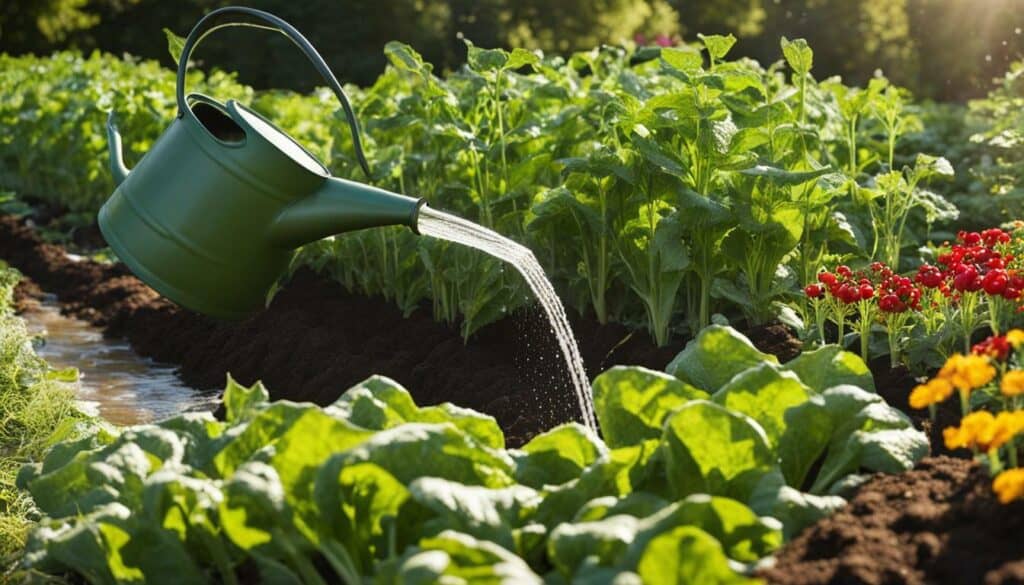
By following these proper watering techniques, you can ensure that your vegetable garden receives the right amount of water, promoting healthy growth and maximizing your harvest. Remember to observe your plants closely, adjusting your watering schedule as necessary to meet their changing needs throughout the growing season.
Understanding the Soil-Plant-Water Relationship
To further optimize soil health and ensure proper watering, it’s essential to understand the relationship between soil, plants, and water. The type of soil in your garden plays a significant role in determining how water is retained and distributed to the plants.
Sandy soils have larger particles and tend to drain quickly, making them prone to dryness. On the other hand, clay soils have smaller particles and retain water for a longer period but can become waterlogged. Loamy soils strike a balance, providing ideal conditions for moisture retention and drainage.
To optimize soil health, consider improving its structure by incorporating organic matter such as compost or well-rotted manure. Organic matter not only helps retain moisture but also promotes healthy microbial activity, enhancing nutrient availability to plants.
| Soil Types and Watering Considerations: |
|---|
| 1. Sandy soil: Water more frequently due to faster drainage. |
| 2. Clay soil: Water less frequently to avoid waterlogging. |
| 3. Loamy soil: Maintain a consistent watering schedule, allowing the soil to dry slightly between waterings. |
Remember to monitor soil moisture regularly and adjust your watering accordingly. By understanding the soil-plant-water relationship, you can optimize watering practices and ensure the health and vitality of your vegetable garden.
Determining Water Needs and Efficient Watering
Every vegetable has different water requirements, so it’s essential to understand how much water each plant needs and how to water them efficiently to maintain a healthy garden. Proper watering techniques not only keep your plants hydrated but also prevent disease and promote optimal growth. To determine the water needs of your vegetables, consider factors such as the plant’s stage of growth, weather conditions, and soil type. Sandy soil, for example, drains quickly and may require more frequent watering compared to clay soil, which retains moisture longer.
Once you’ve assessed the water requirements, it’s time to focus on efficient watering practices. Watering at the base of the plants instead of overhead minimizes evaporation and directs moisture directly to the roots. This helps prevent fungal and other diseases, as leaves should remain dry. Mulching around plants can also conserve moisture by reducing evaporation and suppressing weed growth.
In addition to these practices, tracking rainfall can help you determine when to water. Keep a rain gauge in your garden to measure the amount of precipitation your garden receives. This information will help you adjust your watering schedule accordingly. Remember that underwatering can stunt growth, while overwatering can lead to disease and rot.
| Vegetable | Water Needs |
|---|---|
| Tomatoes | 1-1.5 inches of water per week |
| Lettuce | 1-1.5 inches of water per week |
| Carrots | 1 inch of water per week |
| Peppers | 1-1.5 inches of water per week |
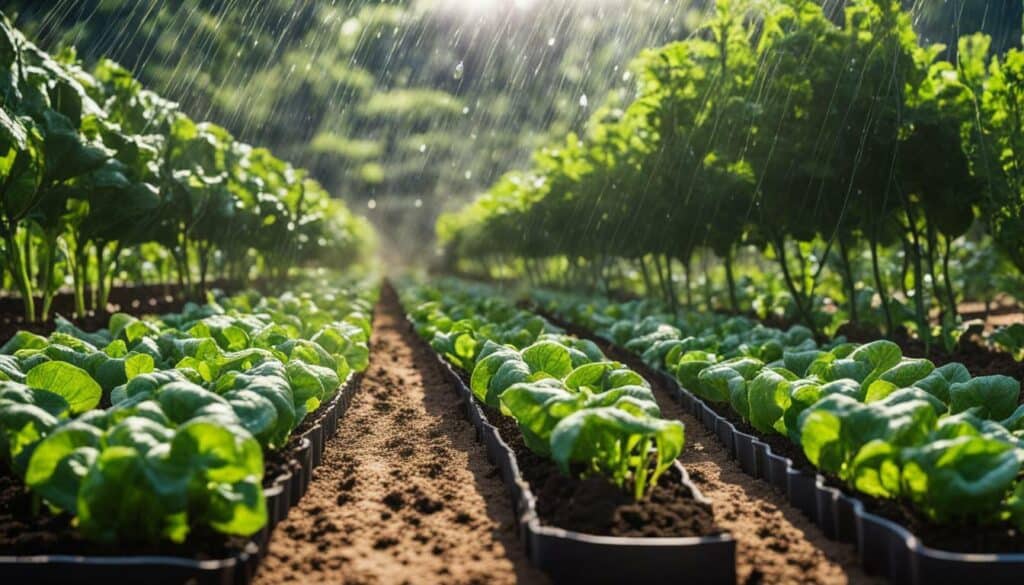
Remember, it’s important to provide enough water for your vegetables to thrive, but not to overdo it. By understanding the water needs of each plant and implementing efficient watering techniques, you can ensure a healthy and flourishing vegetable garden.
Maximizing Sunlight for Healthy Crops
Just like humans, plants need sunlight to thrive and reach their full potential. Discover how to optimize sunlight exposure for a healthy and productive vegetable garden.
When planning your garden layout, it’s crucial to consider the amount of sunlight your garden receives. Most vegetables require at least six to eight hours of direct sunlight per day to grow and develop properly. Observe your garden throughout the day to identify any areas of shade or excessive sunlight. This knowledge will help you determine the best spots to plant your vegetables and make necessary adjustments to maximize sunlight exposure.
One technique to optimize sunlight is to trim or remove any overhanging trees or branches that may cast unwanted shade. This will allow more sunlight to reach your garden and ensure all your vegetables receive the necessary amount of light. Additionally, consider using reflective surfaces, such as white stones or reflective mulch, to bounce sunlight back onto the plants and increase overall exposure.
| Vegetable | Required Sunlight |
|---|---|
| Tomatoes | 6-8 hours |
| Peppers | 6-8 hours |
| Cucumbers | 6-8 hours |
| Leafy Greens | 4-6 hours |
To further optimize sunlight exposure, consider using raised beds or trellises. These structures provide better airflow and ensure that all parts of your vegetables receive equal sunlight. You can also rotate your crops throughout the season to prevent shading and promote uniform sun exposure.
Benefits of Optimal Sunlight Exposure:
- Increased photosynthesis: Sunlight is essential for plants to convert carbon dioxide and water into glucose through photosynthesis. This process fuels their growth and helps in the production of healthy foliage, flowers, and fruits.
- Stronger and more flavorful produce: Vegetables grown in optimal sunlight conditions tend to be more robust, vibrant, and flavorful. They also have higher nutritional value, making them a healthier choice for you and your family.
- Better disease resistance: Sunlight exposure helps plants develop a stronger immune system and enhances their ability to resist diseases and pests.
By prioritizing sunlight in your vegetable garden, you can contribute to the overall health and productivity of your crops. Remember to regularly monitor and adjust your garden’s exposure to ensure your plants receive the maximum benefits of sunlight throughout the growing season.
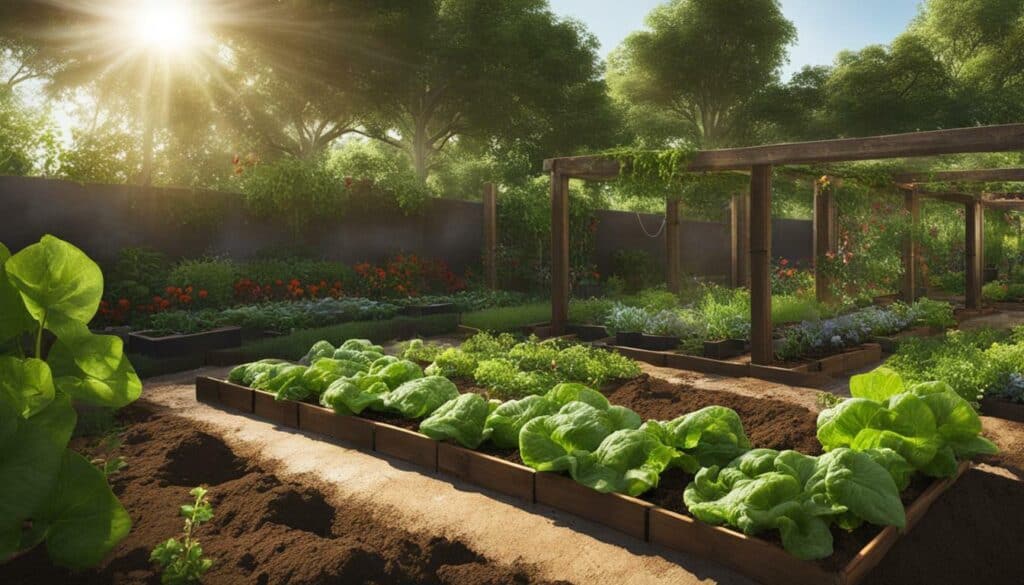
Dealing with weeds is an ongoing battle in any garden, but by implementing the right strategies and incorporating companion planting techniques, you can keep your vegetable garden healthy and weed-free. Managing weeds is essential to ensure that your plants have access to essential nutrients and resources without competing with unwanted vegetation. Here are some effective weed management strategies to help you maintain a thriving garden:
1. Mulching
Applying a layer of organic mulch around your vegetable plants can help suppress weed growth by preventing sunlight from reaching the soil surface, inhibiting weed seed germination. Organic mulch, such as straw or wood chips, also helps retain soil moisture and regulate soil temperature, benefiting your plants in multiple ways. Remember to replenish the mulch as it decomposes over time.
Alongside mulching, consider using biodegradable weed barriers or specialized landscape fabrics to further control weed growth. These materials can be placed directly on the soil surface, creating a physical barrier that prevents weeds from sprouting while allowing water and nutrients to penetrate.
2. Companion Planting
Companion planting involves strategically placing certain plants together to create a mutually beneficial relationship, deterring weeds, and promoting healthy growth. For example, planting aromatic herbs like basil or oregano alongside your vegetables can help repel pests and suppress weed growth. Other beneficial companions include marigolds, which naturally repel harmful nematodes, and legumes like peas or beans, which fix nitrogen in the soil, enriching it for neighboring plants.
Take advantage of companion planting by designing your garden layout in a way that maximizes these beneficial relationships. By doing so, you can create a natural defense system against weeds while fostering a diverse and vibrant garden ecosystem.
3. Regular Maintenance and Hand Weeding
Regular maintenance and hand weeding are crucial to stay on top of weed growth and prevent them from taking over your garden. Inspect your garden regularly, removing any visible weeds by hand, ensuring to remove the entire root system to prevent regrowth. Be cautious when pulling weeds to avoid disturbing the surrounding plants’ roots.
It’s also important to remove weeds before they have a chance to flower and produce seeds, as this can significantly reduce future weed populations. Consider dedicating a specific time each week for weed management to tackle the issue proactively, keeping your vegetable garden healthy and weed-free.
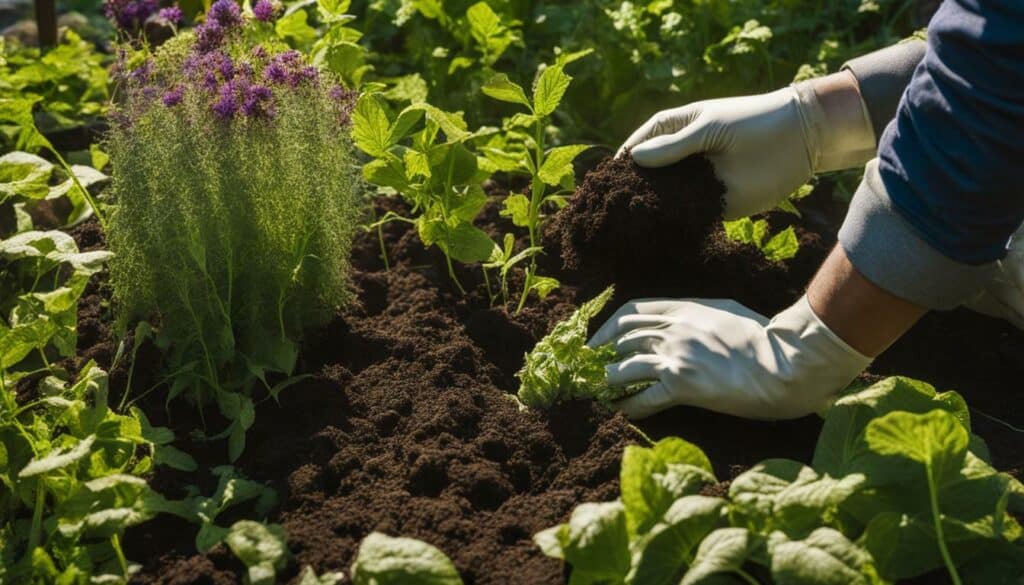
Remember, a healthy garden starts with effective weed management. By implementing these strategies and incorporating companion planting techniques, you can create a beautiful, thriving vegetable garden free from unwanted weeds.
Enhancing Soil Fertility and Health
Creating and maintaining fertile soil is crucial for the success of your vegetable garden. Learn how to enrich your soil using organic gardening techniques and natural fertilizers for vibrant, healthy plants.
One of the first steps in enhancing soil fertility is to understand your soil type. Whether you have sandy soil that drains quickly or clay soil that retains moisture, you can adjust your gardening techniques accordingly. You can optimize soil health by adding organic matter such as compost or well-rotted manure. This will improve soil structure, water retention, and nutrient availability for your plants.
“Compost is often referred to as ‘black gold’ for gardeners. It adds valuable nutrients and beneficial microorganisms to your soil, promoting healthy plant growth.”
To provide essential nutrients to your plants, consider using natural fertilizers. Organic options like bone meal, blood meal, and fish emulsion are excellent choices. These natural fertilizers release nutrients slowly over time, ensuring a steady supply of nourishment for your plants. Remember to follow the recommended application rates to avoid over-fertilization, which can harm plants and the environment.
Companion Planting for Soil Health
Companion planting is another organic gardening technique that can enhance soil health in your vegetable garden. By strategically planting certain crops together, you can create beneficial relationships. For example, planting legumes like beans or peas near heavy feeders like tomatoes can help fix nitrogen in the soil, enriching it naturally. Similarly, aromatic herbs like basil or dill can attract beneficial insects that control pests and improve soil health.
By implementing these organic gardening techniques and utilizing natural fertilizers, you can create a thriving environment for your vegetable garden. The combination of enriched soil, proper watering techniques, and other care practices will lead to vibrant, healthy plants and bountiful harvests.
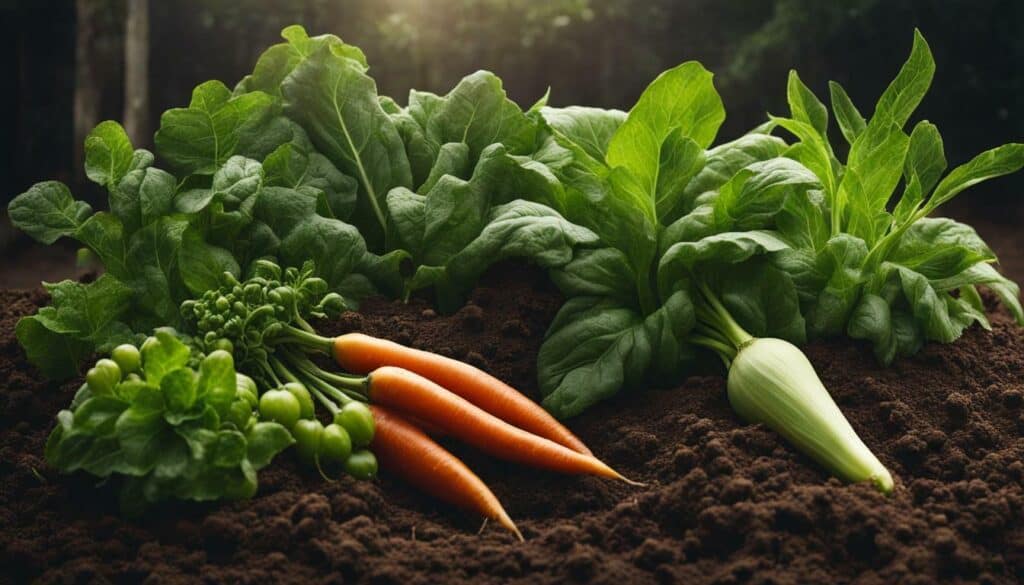
| Organic Gardening Techniques | Natural Fertilizers |
|---|---|
| Composting | Bone meal |
| Using cover crops | Blood meal |
| Crop rotation | Fish emulsion |
| Companion planting | Manure |
Promoting Healthy Soil with Crop Rotation
Implementing crop rotation in your vegetable garden is like giving the soil a refreshing reset. This sustainable gardening practice offers a myriad of benefits, including improved soil health and increased plant productivity. By rotating the types of crops you grow in specific areas of your garden each year, you can break disease cycles, prevent soil depletion, and promote nutrient balance.
There are several ways to incorporate crop rotation into your gardening routine. Begin by dividing your garden into sections based on crop families, such as legumes, brassicas, nightshades, and root vegetables. In each section, plan to grow a different crop family each year, ensuring that plants with similar nutrient needs follow each other.
For example, in the first year, you might plant legumes, which have the ability to fix nitrogen in the soil, improving its fertility. In the second year, switch to brassicas, which are heavy feeders and will benefit from the enriched soil left by the legumes. This rotation pattern can continue, with each crop family following the one that replenishes the necessary nutrients.
| Year | Section 1 | Section 2 | Section 3 | Section 4 |
|---|---|---|---|---|
| 1 | Legumes | Brassicas | Nightshades | Root vegetables |
| 2 | Root vegetables | Legumes | Brassicas | Nightshades |
| 3 | Nightshades | Root vegetables | Legumes | Brassicas |
By following a systematic rotation plan like the one above, you can minimize the risk of soil-borne diseases and pests that target specific plant families. Additionally, crop rotation helps prevent the depletion of particular nutrients, as different crops have varying nutrient requirements. This practice is especially crucial in sustainable gardening, where maintaining soil health and reducing the need for chemical fertilizers are top priorities.

So, if you want to promote healthy soil and ensure the long-term success of your vegetable garden, consider incorporating crop rotation into your gardening routine. By diversifying the crops you grow and strategically rotating them, you can reap the benefits of increased soil fertility, reduced disease pressure, and sustainable gardening practices.
Natural Pest Control for a Pest-Free Garden
As a dedicated gardener, you want to keep pests at bay without resorting to harsh chemicals. Learn effective and natural pest control strategies, including the power of companion planting, to ensure a pest-free garden.
Pest control is an essential aspect of maintaining a healthy vegetable garden. Instead of relying on synthetic pesticides, which can harm beneficial insects and the environment, consider natural alternatives. Companion planting is a powerful technique that involves growing certain plants together to deter pests. For example, planting marigolds alongside your vegetables can repel aphids, nematodes, and other common garden pests. Additionally, herbs like basil, rosemary, and mint emit strong scents that can deter insects.
Another natural pest control method is the use of physical barriers. Row covers can be placed over young seedlings to protect them from insects, while netting or fencing can prevent larger pests like rabbits or deer from accessing the garden. Additionally, handpicking pests such as caterpillars and slugs can be an effective way to control their population, especially in smaller gardens.
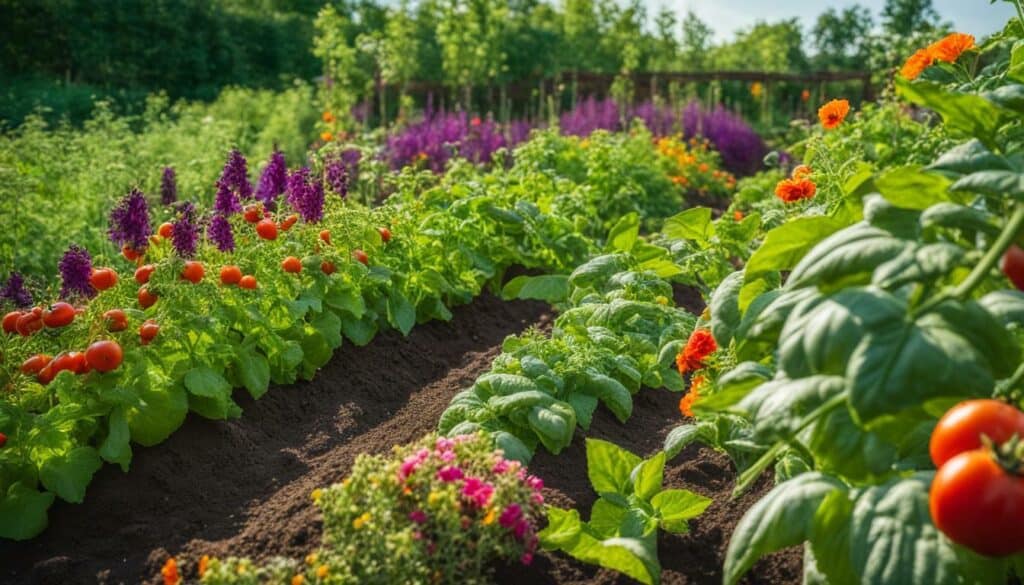
| Pest | Natural Control Method |
|---|---|
| Aphids | Attract ladybugs, lacewings, or parasitic wasps. |
| Slugs and snails | Set up beer traps or introduce natural predators like ducks or frogs. |
| Cabbage worms | Apply Bacillus thuringiensis (Bt) or use floating row covers. |
| Tomato hornworms | Handpick or introduce natural predators like beneficial wasps. |
Creating a diverse and balanced ecosystem in your garden is another effective way to control pests naturally. Encouraging beneficial insects, such as ladybugs, lacewings, and bees, can help keep pest populations in check. This can be achieved by planting flowers that attract these beneficial insects, such as lavender, daisies, and sunflowers.
By incorporating these natural pest control strategies into your gardening routine, you can maintain a pest-free garden while promoting a healthy and thriving ecosystem. Remember, a little bit of prevention and proactive planning can go a long way in ensuring the success of your vegetable garden.
The Battle Against Weeds
Don’t let weeds take over your vegetable garden. Arm yourself with sustainable weed management practices to maintain a thriving and weed-free garden. Effective weed control is essential for the health and productivity of your plants.
One of the most important strategies for managing weeds is to create a weed barrier. Start by clearing any existing weeds from your garden beds. Then, lay down a layer of organic mulch, such as straw or wood chips, to help suppress weed growth. This will also help retain moisture in the soil, reducing the need for frequent watering.
Another sustainable weed management practice is to practice regular cultivation. Use a hoe or hand tools to remove weeds while they are still small and easy to handle. Be careful not to disturb the roots of your vegetable plants while doing so. Regular cultivation will prevent weeds from establishing deep root systems, making it easier to control them.
Companion planting can also play a role in managing weeds. Some plants, such as marigolds, can help repel weeds and attract beneficial insects that prey on pests. By interplanting these companion plants with your vegetables, you can naturally deter weed growth and promote a healthy garden ecosystem.
| Weed | Control Methods |
|---|---|
| Dandelion | Regular cultivation, hand-pulling, deep root removal |
| Bindweed | Removing roots, regular cultivation, mulching |
| Crabgrass | Preventive measures (thick mulch, proper lawn care), hand-pulling, herbicides (as a last resort) |
| Purslane | Hand-pulling, regular cultivation, mulching |
Remember, sustainable gardening practices not only help control weeds but also contribute to a healthy and environmentally friendly garden. By implementing these strategies, you can enjoy a weed-free vegetable garden and optimize the growth and yield of your crops.
Nurturing Your Garden for Optimal Growth
Your vegetable garden requires regular care and nurturing to reach its full potential. Discover the essential techniques for promoting optimal growth and maintaining a healthy, productive garden.
To ensure your vegetables thrive, it’s crucial to understand the importance of organic gardening techniques. By utilizing natural fertilizers, you can provide essential nutrients to your plants without the use of harmful chemicals. Organic fertilizers such as compost, manure, and bone meal improve soil health and enhance the overall growth of your crops. Incorporating these natural fertilizers into your garden beds before planting and as needed throughout the season will provide your vegetables with the nutrients they need to flourish.
Optimizing soil health is another key aspect of nurturing your garden. Conduct a soil test to determine its pH level and composition. This will help you understand its fertility and any necessary amendments. Adjusting the pH level to neutral or slightly acidic (around 6.5) will ensure optimal nutrient absorption. Adding organic matter like compost or well-rotted manure to the soil will improve its structure, drainage, and water retention abilities, setting the stage for healthier plants.
| Organic Gardening Techniques | Natural Fertilizers for Vegetables |
|---|---|
| Companion planting | Compost |
| Crop rotation | Manure |
| Intercropping | Bone meal |
Finally, the key to nurturing your garden lies in regular maintenance. Watering your plants properly is crucial for their growth and productivity. Aim to provide about one inch of water per week, either through rainfall or irrigation. Regular weeding and removing dead plant material will minimize competition for nutrients and reduce the risk of disease. Additionally, keep a close eye on your plants for signs of pests or disease. Early detection and appropriate treatment will help keep your garden healthy and thriving.

By following these nurturing techniques, you can create an environment that promotes optimal growth and ensures a bountiful harvest. With proper care, your vegetable garden will reward you with an abundance of fresh and healthy produce throughout the growing season.
Conclusion on How Can You Keep Your Vegetable Garden Healthy
With the knowledge and insights gained from this article, you now have the tools to create and maintain a healthy vegetable garden that will provide you with fresh, homegrown produce for years to come.
Proper watering techniques and understanding your soil type are essential for the health of your vegetable garden. Knowing how much water your plants need and tracking rainfall can help you water efficiently, preventing disease and stunted growth. Watering at the base of the plants and avoiding overhead watering will keep the leaves dry and reduce the risk of fungal and other diseases.
In addition to water, sunlight is crucial for the growth and productivity of your vegetables. Making sure your garden receives enough sunlight and has access to a water source are important factors to consider.
Preventing weeds and attracting beneficial insects are also key to maintaining a healthy vegetable garden. Managing weeds and using companion planting techniques can help reduce competition for nutrients and space, promoting the optimal growth of your crops.
Lastly, providing fertile soil and taking the necessary steps to water, weed, and fertilize your plants as needed will ensure their overall health and productivity. By implementing these organic gardening techniques and following these vegetable garden care tips, you can create a thriving and abundant vegetable garden that will provide you with a bountiful harvest for years to come.
FAQ on How Can You Keep Your Vegetable Garden Healthy
Q: How often should I water my vegetable garden?
A: The frequency of watering depends on various factors, including the type of plants and soil you have. Generally, it’s best to water deeply and less frequently rather than shallowly and frequently. Aim for about 1 inch of water per week, either through rainfall or irrigation.
Q: Should I water my vegetables from above or at the base?
A: It’s recommended to water your vegetables at the base of the plants rather than from above. Watering at the base ensures that the roots receive the water they need, while minimizing the risk of fungal and disease issues. Additionally, keeping the leaves dry can help prevent the spread of diseases.
Q: How can I prevent weeds in my vegetable garden?
A: To prevent weeds, regularly remove any existing weeds by hand or with a hoe. Applying a layer of mulch around your plants can also help suppress weed growth. Additionally, practicing companion planting, where certain plants are grown together for mutual benefits, can help deter weeds.
Q: How much sunlight does my vegetable garden need?
A: Most vegetables require at least 6 hours of direct sunlight per day to grow and thrive. However, some leafy greens and herbs can tolerate less sunlight. Consider the amount of sunlight your garden receives and choose plants accordingly to ensure they have adequate light for healthy growth.
Q: What type of soil is best for a healthy vegetable garden?
A: A fertile, well-draining soil is ideal for a healthy vegetable garden. Adding organic matter, such as compost or aged manure, can improve soil fertility and structure. Conduct a soil test to determine its pH level and nutrient content, and make any necessary amendments based on the test results.

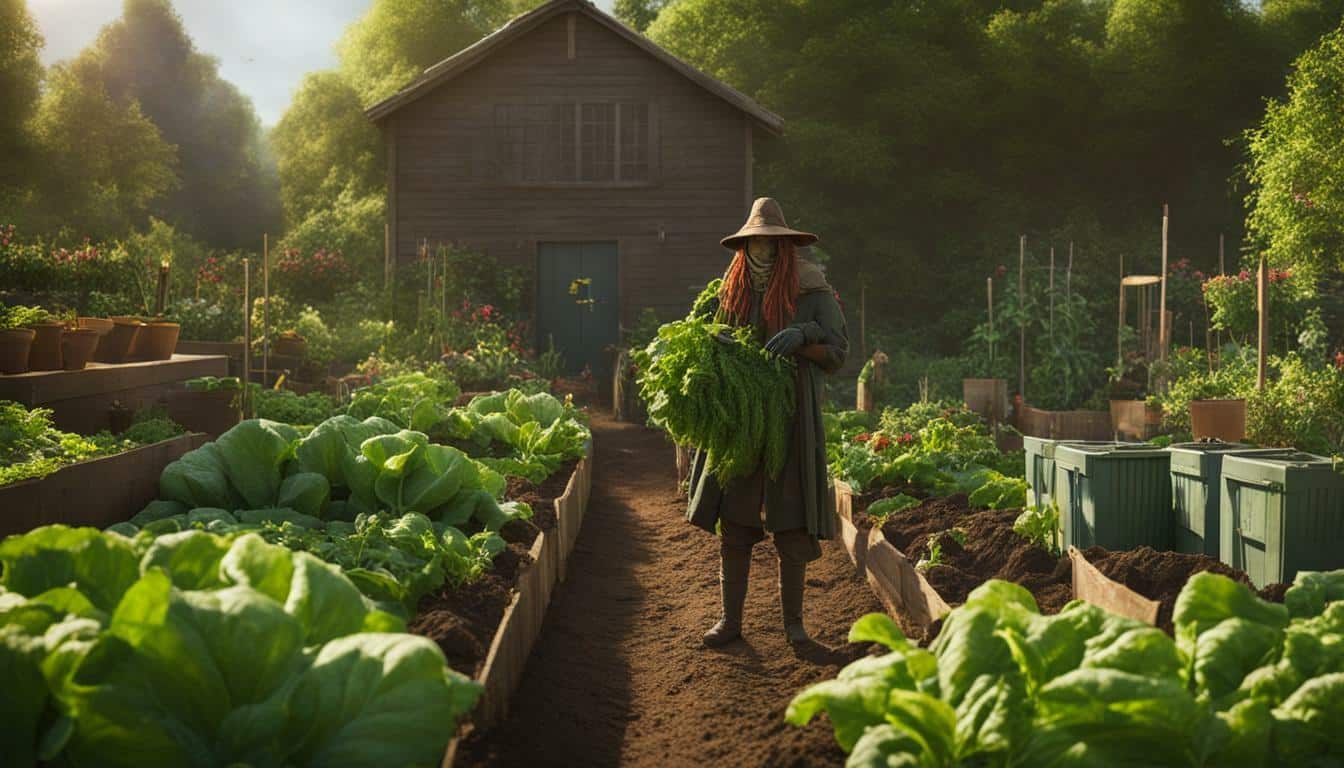



Leave a Reply